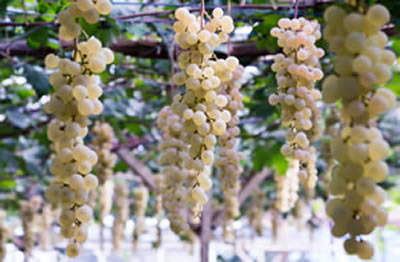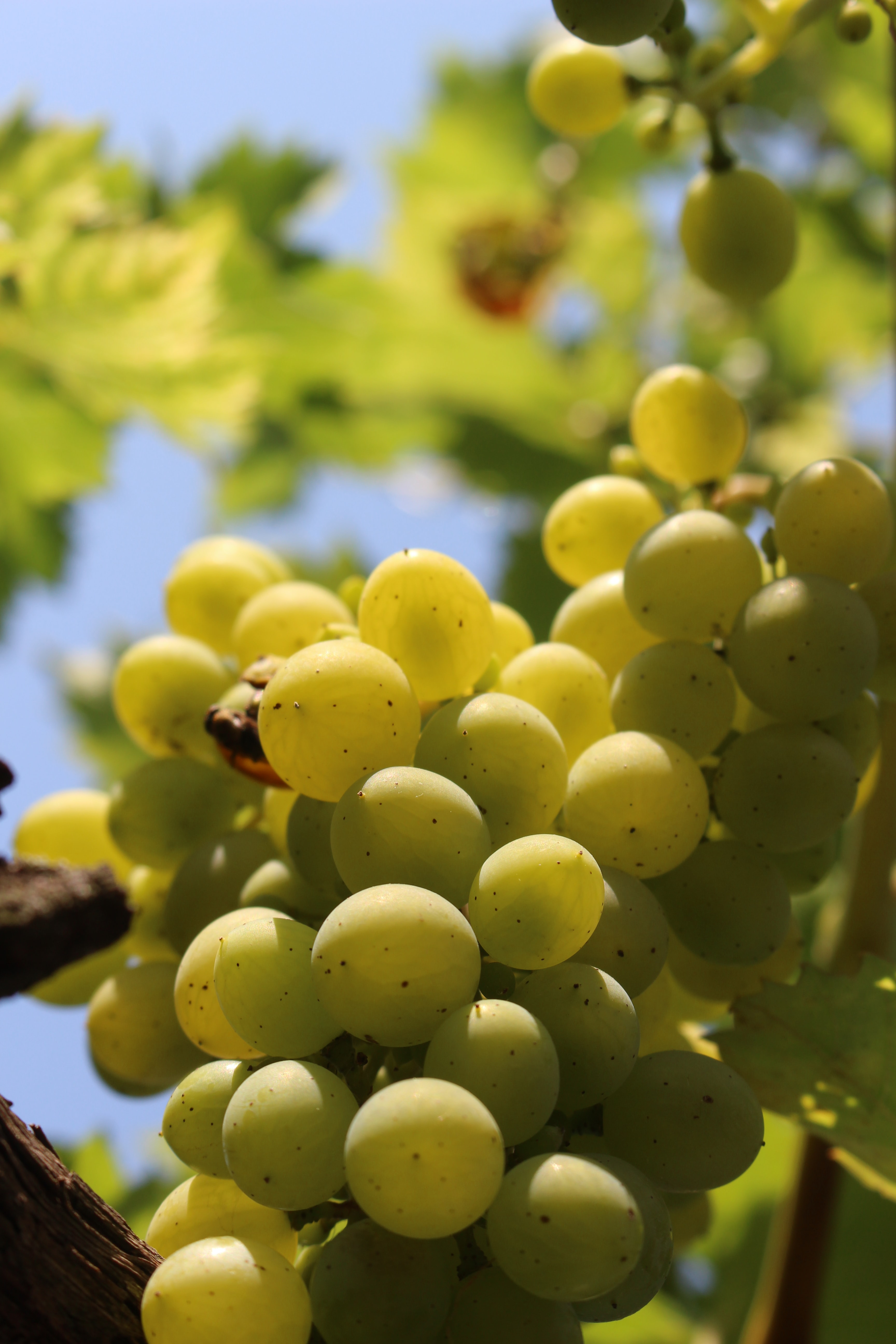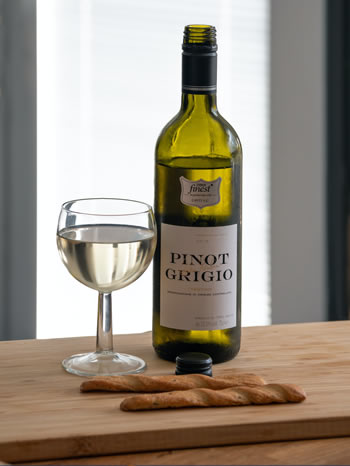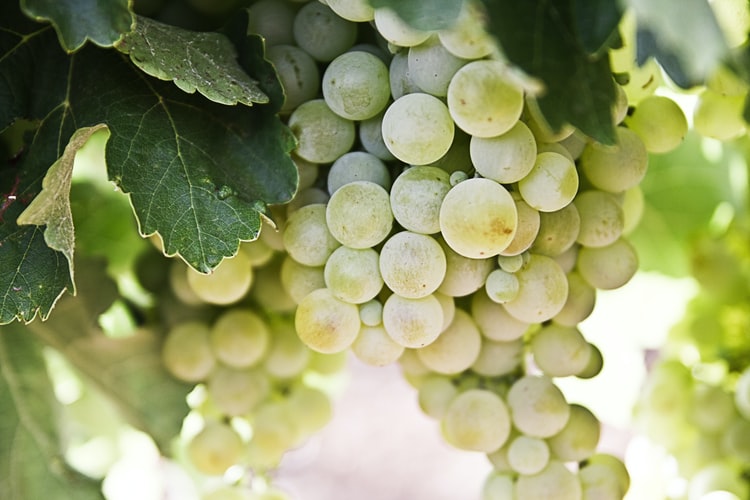WHITE WINE CHARACTERISTICS
White Wines
White wines are produced from white grapes, which are green or yellow in color (simple enough, right?). After harvesting the grapes, the clusters go through a destemming machine to separate the grapes from the stems. Then they are pressed to remove the juice and pulp from the skins. Basically, there are two methods of pressing the grapes. The grapes can be sent to a bladder press, which acts like a balloon that is inflated inside the tank. The pressure forces the grapes to the sides of the tank, pushing the juice through screens and then pumped into chilled tanks where fermentation takes place. The second method uses a steel basket press that pushes down on the grapes to squeeze the juice out of the skins, which are left behind to be composted. Depending on the  winemaker’s desired style of wine, malolactic fermentation (ML) can be introduced as a secondary fermentation. Instead of yeast, ML is a step where bacteria converts malic acid (Granny Apple-like tartness) to lactic acid (buttery tasting). This step is desirable in a rich Chardonnay or a Viognier.
winemaker’s desired style of wine, malolactic fermentation (ML) can be introduced as a secondary fermentation. Instead of yeast, ML is a step where bacteria converts malic acid (Granny Apple-like tartness) to lactic acid (buttery tasting). This step is desirable in a rich Chardonnay or a Viognier.
There are hundreds of white wines being produced around the globe. We will focus on a few of the favorite whites that people love to drink. Chardonnay, Pinot Grigio, and Sauvignon Blanc are three of the most popular white wines in today’s world. They each have their own style and flavor, and pair well with different foods. Let’s explore each one and see how you can add them to your next dinner party!
CHARDONNAY
Chardonnay is a grape that is so versatile, it is a great choice whether you’re looking to pair it with food or just want to kick back and enjoy a glass or two out on the patio! What influences the different flavors and styles of Chardonnay? Naturally, the location of the vineyards is of utmost importance. For example, Carneros is an American Viticultural Area (AVA) located north of the San Pablo Bay, at the southern end of Napa  Valley and part of Sonoma Valley (it’s the only AVA located in both counties). The climate in Carneros is ideal for Chardonnay. The temperature is more moderate due to the fog, marine air, and cool breezes blowing in from the Bay. Carneros Chardonnays can be more elegant and tend to showcase higher acidity than other California Chardonnays. The winemaker is the person who decides what style to create. They may decide on a full-bodied, buttery Chardonnay rather than a crisp and lighter-bodied wine. To produce a crisp wine, the Chardonnay will usually be aged in stainless steel. You might notice a bit of minerality on your palate. If the winemaker is looking for a big, creamy, and buttery Chardonnay, then the wine will see some time in oak. Either style is so easy to pair with food. The best temperature to serve Chardonnay is 50-55 degrees Fahrenheit. Any colder than that and you will mute the flavors. If you are planning a dinner party and want to include Chardonnay, please contact me for insight to the perfect pairing of food and wine for your guests.
Valley and part of Sonoma Valley (it’s the only AVA located in both counties). The climate in Carneros is ideal for Chardonnay. The temperature is more moderate due to the fog, marine air, and cool breezes blowing in from the Bay. Carneros Chardonnays can be more elegant and tend to showcase higher acidity than other California Chardonnays. The winemaker is the person who decides what style to create. They may decide on a full-bodied, buttery Chardonnay rather than a crisp and lighter-bodied wine. To produce a crisp wine, the Chardonnay will usually be aged in stainless steel. You might notice a bit of minerality on your palate. If the winemaker is looking for a big, creamy, and buttery Chardonnay, then the wine will see some time in oak. Either style is so easy to pair with food. The best temperature to serve Chardonnay is 50-55 degrees Fahrenheit. Any colder than that and you will mute the flavors. If you are planning a dinner party and want to include Chardonnay, please contact me for insight to the perfect pairing of food and wine for your guests.
PINOT GRIGIO
Pinot Grigio and Pinot Gris are different names for the same grape, but they’re worlds apart when it  comes to style and taste. Pinot Grigio is a mutation from the Pinot Noir grape (hmm…does that make them cousins?). The color of the grape is normally a grayish-blue fruit. Pinot Grigio is the Italian name for the grape and grows very well in the northeastern part of Italy (Friuli-Venezia Giulia region).
comes to style and taste. Pinot Grigio is a mutation from the Pinot Noir grape (hmm…does that make them cousins?). The color of the grape is normally a grayish-blue fruit. Pinot Grigio is the Italian name for the grape and grows very well in the northeastern part of Italy (Friuli-Venezia Giulia region).
It is dry, light-bodied, and crisp, with zesty citrus flavors. Due to its popularity, Pinot Grigio has become mass-produced to meet with the demand for this easy-drinking white! Pinot Gris is associated with a French style, richer, full-bodied and more fruit-driven (white peach, Meyer lemon come to mind). It thrives in the Alsace region of France (hence, the name “gris” which is French for “gray”). I would love to help you find a delicious bottle the next time you are ready to buy a Pinot Grigio or a Pinot Gris.
SAUVIGNON BLANC
Sauvignon Blanc is a green-skinned grape variety. There is a range of flavors that you can find in a Sauvignon Blanc, depending upon the climate, the source of the grapes, and the style of winemaking. New Zealand Sauvignon Blanc is known to showcase grapefruit, gooseberry, grassy notes (think fresh cut grass!) and high acidity. A richer, more full-bodied Sauvignon Blanc is made by blending it with Semillon or Muscadelle and produced in oak barrels. California Sauvignon Blanc tends to be the latter, with delicious round flavors of passionfruit, gooseberry, and tropical fruit. In France, you will see the appellation on the wine label rather than the varietal, contrary to the United States and some other countries. For example, when you read “Sancerre” on a wine bottle, that is telling you that the Sauvignon Blanc is from the Upper Loire Valley. It is recognized for its high acidity, citrus and gooseberry flavors, and flinty minerality. Pinot Noir accounts for approximately 20% of the production in the region, under the designation of Sancerre Rouge, but most is consumed locally. Proper serving temperature for Sauvignon Blanc is 45 to 50 degrees Fahrenheit. Let me know if you’re interested in hearing more about Sancerre, which has changed my opinion about Sauvignon Blanc! I absolutely love it!
Please don't waste another $20-$30 drinking a disappointing wine, let me show you how!

